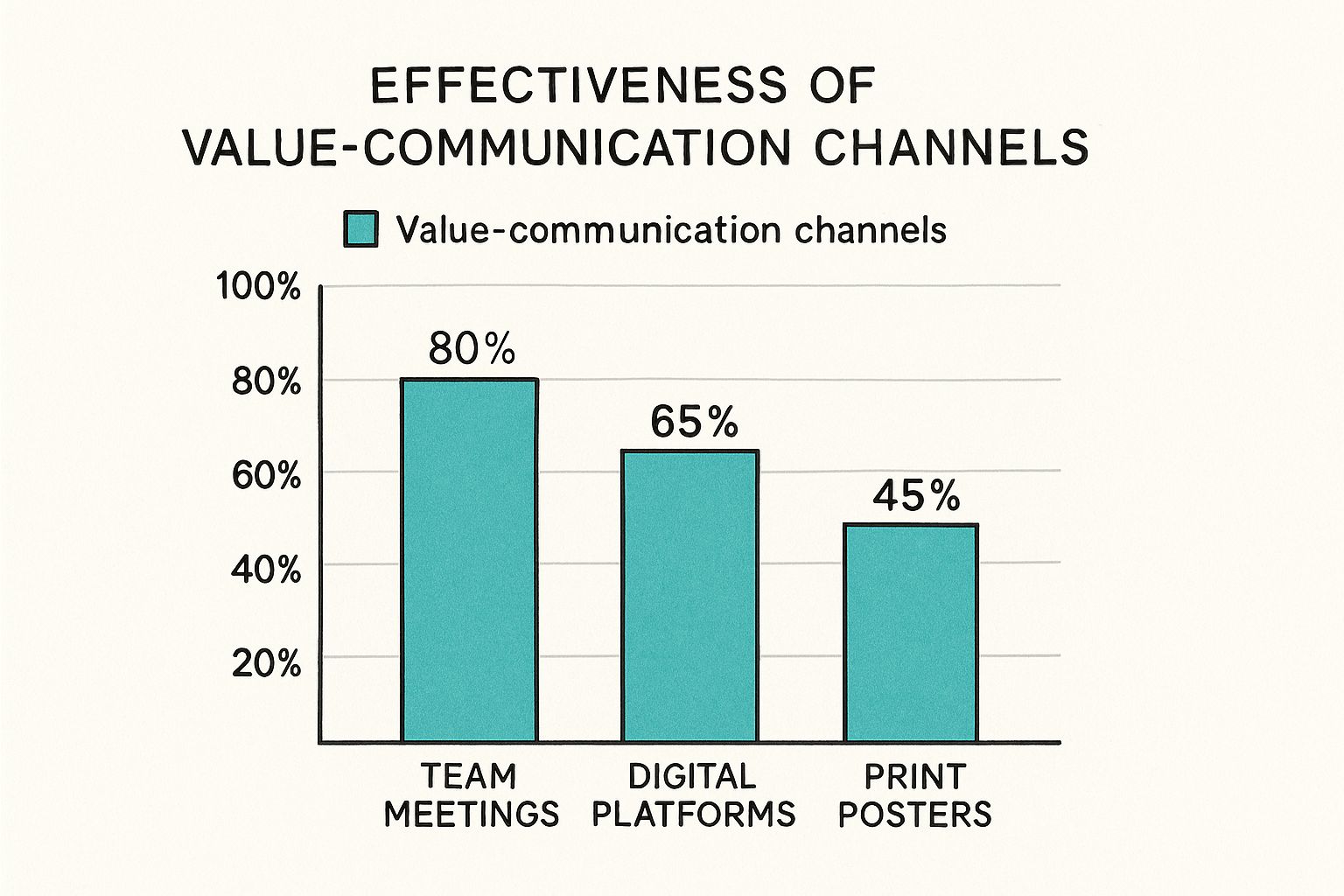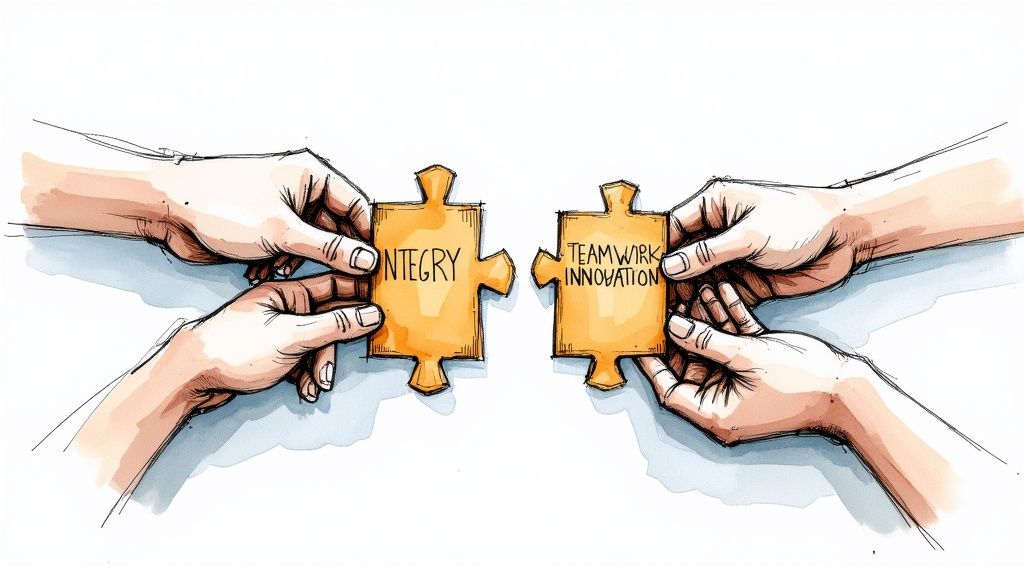Unlocking Success with Company Values

Company values are the heart and soul of your organization. They’re the fundamental beliefs that act as your North Star, influencing everything from high-level strategy down to the smallest daily interactions. Think of them less as a set of rules and more as your company’s unique strategic DNA—the code that shapes your culture, guides your decisions, and defines your place in the world.
Why Company Values Are Your Greatest Strategic Asset

It’s easy to dismiss company values as corporate fluff—nice-sounding words that end up on a poster in the breakroom but don't mean much in the real world. That's a huge mistake. When done right, your values are one of the most powerful tools in your strategic arsenal, directly impacting your bottom line. They are the quiet, internal operating system that runs in the background, shaping every single choice and action.
Imagine trying to build a skyscraper on a shaky foundation. It wouldn’t stand a chance. The same goes for your business. Without a solid set of guiding principles, you’ll constantly struggle with misalignment, find it hard to attract the right people, and never achieve the kind of growth that lasts.
The Real-World Impact on Your Team
Let's get practical. Authentic company values aren't just abstract ideas; they build an environment where people feel a genuine sense of connection and purpose. This connection is the fuel for employee engagement and retention.
The link between a strong culture and a dedicated team is impossible to ignore. A 2021 Achievers report highlights this connection.
Research shows that when employees feel deeply connected to their company's culture, they are a staggering 3.7 times more engaged at work. This sense of belonging also makes them 68% less likely to burn out, proving that a values-driven culture is a direct investment in your people's well-being.
This engagement translates directly into stability. In companies battling high turnover, business units with highly engaged teams see 21% fewer people leave. And in organizations where turnover is already low, that number jumps to an incredible 51% according to Gallup. You can dig into more eye-opening numbers in these workplace culture statistics from KinkajouConsulting.com.
From Wall Posters to Bottom-Line Results
When leaders not only define but actively live out the company's values, they transform them from abstract concepts into a practical guide for how work gets done every day. This alignment sends powerful ripples throughout the entire organization.
The data connecting strong values to tangible business outcomes is compelling. When your culture is clear and lived out, the benefits are felt across the board.
Here’s a quick look at how well-defined values drive quantifiable success, with data from various industry reports.
The Tangible Impact of Well-Defined Company Values
| Business Area | Impact of Strong Company Values | Supporting Statistic |
|---|---|---|
| Employee Engagement | Creates a connected workforce where people feel they belong. | Employees who feel connected to their culture are 3.7 times more engaged (Achievers, 2021). |
| Employee Retention | Builds loyalty and significantly reduces costly turnover. | Highly engaged teams can reduce turnover by up to 51% in low-turnover organizations (Gallup). |
| Talent Acquisition | Attracts top talent who are a natural fit for your mission. | 88% of employees say a strong company culture is important to their success (Jobvite, 2021). |
| Financial Performance | Drives higher profitability and long-term business health. | Companies with healthy cultures are 1.5 times more likely to report average revenue growth of over 15% for three years (McKinsey, 2021). |
Ultimately, a strong set of values serves as a practical framework that empowers your team and strengthens your business from the inside out. They provide clarity, attract the right people, and build the kind of loyalty that money can't buy. By treating your values as the critical strategic tool they are, you pave the way for real, measurable business results.
How to Define Values That Actually Mean Something
Let's be honest. Generic company values like 'Integrity' or 'Innovation' often end up as nothing more than hollow buzzwords. They look nice on a poster in the breakroom, but they don't actually guide anyone's behavior because they lack real teeth. To create values that truly matter, you have to move past these fuzzy concepts and build a practical, behavioral constitution for your organization.
Think of your values as the specific operating instructions for your culture. They should be memorable and actionable—clear enough to help an employee make a tough call when their manager isn't around. This isn't a top-down exercise where executives dictate principles from an ivory tower. It’s about working together to uncover what already makes your best people tick.
Start with Discovery, Not Invention
Here’s a secret: your strongest values are already alive and well within your company. You can see them in action every day in your top performers. The real job isn't to invent aspirational platitudes but to discover and formalize the behaviors that are already driving your success.
The first step is to ask the right questions and, more importantly, to listen.
Get a group of employees together that represents a real cross-section of your company—not just the leadership team. You need new hires, seasoned veterans, and people from every department and level of seniority. This diversity is the only way to get a complete picture of your culture as it truly is.
Once you have them in a room, steer the conversation toward concrete behaviors and stories:
- Identify Your Stars: Ask, "Who are the people we all look up to around here, and what exactly do they do that makes them so great?"
- Deconstruct Your Wins: Think about a recent project that knocked it out of the park. What specific behaviors and decisions made that happen?
- Examine the Tough Calls: Talk about a time the company faced a difficult choice. What principles guided that decision, even when it hurt?
Think of it as an archaeological dig for your culture's DNA. You're unearthing the real-world actions that define who you are when you're at your absolute best.
From Behaviors to Action-Oriented Statements
Once you've collected a bunch of stories and observed behaviors, it's time to translate them into clear, concise value statements. Remember, generic words fail because they mean different things to different people. A powerful value, on the other hand, describes an action you can actually see.
For example, instead of just "Integrity," you might land on something like, "Do what's right, even when no one is watching." This instantly sets a behavioral standard. Instead of a vague commitment to "Innovation," try "Embrace curiosity and challenge 'the way we've always done it'."
A 2018 article from the MIT Sloan Management Review found that when customers sense a gap between a company's stated values and its actual behavior, sales can drop by as much as 30%. This really drives home the point that values must be authentic and lived out, not just feel-good internal slogans.
As you draft your value statements, run them through this simple checklist:
- Is it behavioral? Does it describe a way of acting?
- Is it unique? Does it capture what makes your company different from the one down the street?
- Is it memorable? Can people easily recall and repeat it?
This is the step that turns your values from fuzzy ideals into a practical field guide for your team. Getting everyone on the same page is the bedrock of a strong culture. To dive deeper into this, read our guide on achieving values alignment in the workplace and building an organization with purpose. When you get it right, these carefully chosen words become the lived, breathed reality of your company.
Winning the Modern War for Talent with Your Values

In a job market where top candidates have plenty of options, the old recruiting playbook just doesn't work anymore. Of course, a good salary and solid benefits are still table stakes. But they aren't the knockout punch they used to be. Today, the real battle for talent is fought and won on the field of company culture, and your company values are the sharpest tool in your arsenal.
Think of your values as a powerful magnet. When you put them out there, they pull in candidates who aren't just qualified for the role but are a perfect fit for your mission and your way of doing things. Just as importantly, they act as a filter, gently pushing away people who wouldn't thrive in your environment. That alone can save you from a world of headache and costly hiring mistakes.
The New Currency in Recruiting: Culture
For today’s professionals, especially the younger generations just starting their careers, a great cultural fit isn't a "nice-to-have." It’s a dealbreaker. This fundamental shift is forcing companies to rethink how they compete for the best and brightest.
The proof is in the data. Jobvite's 2021 Recruiter Nation Report found that 88% of employees across the globe believe a strong culture is important. This priority is even sharper for Gen Z, with a 2022 survey by Ripplematch revealing that an incredible 69% would pick a company with a great culture over one that offered a higher salary. With an estimated 50 million new businesses popping up every year according to the World Bank, all chasing the same talent pool, a weak or undefined culture puts you at a serious disadvantage. You can see more stats on why company culture is critical at Ujji.io.
What this all means is that candidates aren't just looking for a paycheck anymore. They're searching for a place to belong, a place where their work feels meaningful.
Weaving Values into Your Hiring Process
To turn your values into a true recruiting advantage, you have to do more than just list them on your "About Us" page. You need to weave them into every single step of your hiring process. This turns every interaction into a living, breathing demonstration of who you are as a company.
Here’s how you can embed your values from the very first touchpoint:
- Your Career Page: This is your front porch. Instead of just posting job openings, use it to tell your culture story. Share videos of your team, feature employee testimonials, and showcase a "day in the life" that brings your values to life. Show, don't just tell.
- Job Descriptions: Ditch the robotic list of duties. Use language that echoes your values. If collaboration is a core value, talk about how the role interacts with other teams. If you value autonomy, highlight the ownership and freedom the new hire will have.
- Interview Questions: Move beyond the generic questions everyone asks. Design questions that actually test for values alignment. Instead of asking, "Are you a team player?" try a behavioral question like, "Tell me about a time you disagreed with a coworker. How did you resolve it?" The story they tell will reveal far more than a simple yes or no.
When you hire for values, you build a team that is not only skilled but also deeply invested in your company's purpose. This kind of alignment is the secret sauce for long-term retention and high performance.
Ultimately, this values-first approach changes recruiting from a simple transaction into a genuine conversation. You stop just filling empty seats and start building a team of people who are excited to help you succeed. It's the only way to build a real culture of engagement where everyone is rowing in the same direction.
Embedding Your Values From the Boardroom to the Frontline
So, you've nailed down your company values. That’s a fantastic start. But think of it like writing sheet music for an orchestra—the notes on the page are just the beginning. The real magic happens when every single musician brings that music to life, playing in perfect harmony. In the same way, the true test of your values isn't how they sound in a mission statement, but how they’re lived out in every corner of your business, every single day.
The real work starts now. It's about weaving these values into the very DNA of your organization. They need to become the default operating system for every decision, process, and conversation, guiding behavior naturally from the C-suite to the newest person on the frontline.
Weaving Values Into Daily Operations
To make your values truly stick, you have to move them off the posters on the wall and build them into your core business processes. It's like upgrading your company's internal software—you have to install the new values across every single application.
Here are the key areas to focus on:
- Performance Management: Stop making performance reviews only about what people achieve. Start focusing equally on how they achieve it. Did your top salesperson hit their numbers by embodying your value of collaboration, or did they leave a trail of burned bridges? Tying values to performance makes them a tangible part of career growth.
- Recognition and Rewards: When you see someone perfectly demonstrating a company value, celebrate it. Loudly and publicly. Rewarding employees who are shining examples of your values in action sends a powerful signal to everyone else about what your company truly prizes.
- Leadership Development: Your leaders must be your chief evangelists for your values. Train them to coach their teams on value-aligned behaviors, to use the values as a guidepost for resolving conflict, and, most importantly, to model those principles themselves.
This kind of consistent reinforcement is what turns abstract ideals into a practical, everyday framework for how work gets done.
The Action Plan for Embedding Company Values
To make this more concrete, you need a clear action plan. The table below breaks down how you can integrate your values across different business functions and measure your success along the way.
| Organizational Function | Action to Embed Values | Success Metric |
|---|---|---|
| Hiring & Onboarding | Integrate value-based questions into interviews. Feature values in new hire orientation. | Increased percentage of new hires who are a strong culture fit. |
| Performance Reviews | Add a section to reviews assessing how employees demonstrated company values. | Improved scores on value-related performance metrics. |
| Internal Communications | Share stories of employees living the values in newsletters and all-hands meetings. | Higher employee engagement scores related to feeling connected to the company's mission. |
| Leadership Training | Develop modules focused on leading with values and making value-based decisions. | Leaders consistently reference values when communicating decisions and giving feedback. |
By systematically embedding values into these key areas, you create a self-reinforcing loop that strengthens your culture over time.
The Power of Leadership and Communication
Ultimately, leadership isn't just a piece of the puzzle—it's the most critical piece. People look to their leaders for cues on what really matters. When a leader consistently walks the talk, it gives everyone else the permission and the encouragement to do the same.
Communicating your values effectively is just as crucial. This image shows which channels truly get the message across.

The data is clear: personal, interactive channels like team meetings are miles ahead of passive methods like posters. This tells us that values are best shared through real dialogue and human connection, not just broadcasted from on high.
The goal is to reach a point where your values are so deeply embedded that your culture starts to police itself. People will naturally notice and correct behaviors that don't align, creating a truly cohesive and resilient organization.
For a deeper dive into this process, our guide on building culture at work is a great next step. Once your values are truly part of the fabric of your company, you can see their impact reflected in metrics like your employee key performance indicators. Remember, embedding values is an ongoing commitment that transforms your principles from words on a wall into the beating heart of your organization.
How to Measure the ROI of Your Company Values
Proving the value of something as seemingly intangible as your company values can feel like trying to catch smoke. But if you want to secure real resources and get leadership on board, you have to move beyond feelings and into hard data. This is how you shift your culture from a "nice-to-have" expense to a core business asset.
The trick is to draw a straight line from your values to specific, measurable business outcomes. You can't put a dollar sign on "integrity," but you can absolutely measure its effect on employee turnover, customer loyalty, and even how efficiently your teams operate. The right metrics act as a compass, telling you whether your culture is truly guiding your business or just gathering dust on a poster.
Key Metrics for Your Values Dashboard
To get a clear picture of what's happening, you need a mix of what we call leading and lagging indicators. Leading indicators, like employee feedback, give you an immediate sense of cultural health. Lagging indicators, like retention rates, show you the results of that health over time.
Think of it like building a dashboard for your culture. Here are the essential gauges you need to include:
Employee Net Promoter Score (eNPS): This boils it all down to one powerful question: "On a scale of 0-10, how likely are you to recommend our company as a place to work?" A high eNPS is a fantastic sign that your people feel connected to the company's mission and values.
Employee Engagement Survey Results: Don't just look at the overall score. Modern surveys let you slice and dice the data, breaking down engagement by team or department and even linking responses back to specific company values. Keep an eye out for high scores in areas like "I feel my work has purpose" or "I trust my manager."
Voluntary Turnover and Retention Rates: This is where the rubber really meets the road financially. High turnover is incredibly expensive. When people choose to stay, it’s often because they feel a genuine connection to the culture. Tracking retention among your top performers is particularly telling.
Gathering Real-Time Culture Data
Annual surveys are great for a yearly check-up, but your culture is a living, breathing thing that changes daily. To get a true sense of how your values are being lived out, you need a more continuous feedback loop. This is where modern tools can make a huge difference.
Pulse surveys—those short, frequent check-ins—can give you a real-time pulse on team morale and values alignment. They can be as simple as a one-question poll sent out weekly asking employees how well the team lived up to a specific value, like "Collaboration."
A 2021 study by McKinsey & Company on purpose uncovered a massive disconnect: while 70% of employees say their sense of purpose is defined by their work, a staggering 15% of non-executives feel they are actually living that purpose on the job. This gap is precisely what a values dashboard is designed to close, by making purpose something you can actively measure and manage.
Culture assessment tools take this a step further. They are built specifically to quantify how well an individual's behaviors match up with the organization's core principles. By gathering this kind of data, you can spot teams where the values are thriving and identify others that might need more coaching and support. For a deeper dive into how this works, our guide to core values assessment offers a structured approach to measuring this alignment.
Connecting Values to Customer and Business Outcomes
The ripple effect of your values doesn't stop at your office doors—it flows directly to your customers and your bottom line. It's simple, really: happy, engaged employees who believe in what they're doing deliver better service.
Consider adding these metrics to your dashboard to complete the picture:
Customer Satisfaction (CSAT) and Net Promoter Score (NPS): Try correlating your eNPS scores with your customer-facing NPS. You'll often find a direct link—teams with the highest internal engagement usually have the happiest customers.
Productivity and Innovation Metrics: Look at things like the number of new ideas submitted by employees or how quickly projects are completed. A culture that genuinely values "Ownership" or "Constant Improvement" will see tangible results in these areas.
By tracking these different data points, you build a powerful story. You can walk into any meeting and clearly show how investing in a value-driven culture leads directly to a more engaged workforce, happier customers, and a healthier business.
Amplifying Your Values with Modern Technology

As your company grows, the personal touch that defined your early culture can get lost in the noise. It’s a common growing pain. What works for a tight-knit team of 20 often starts to fray with 200 employees and can completely fall apart by the time you hit 2,000.
This is where technology can be a game-changer. I’m not talking about replacing the human element of your culture, but about giving it the tools to scale. Modern platforms are designed to amplify your company values, ensuring they remain the heartbeat of your organization no matter its size.
Think of it this way: technology can give your values both a megaphone and a microscope. It helps broadcast your principles far and wide while also letting you zoom in on how they're truly playing out day-to-day.
Automating Recognition and Reinforcing Behaviors
One of the best ways to keep your values alive is to celebrate them in action. When people see their colleagues being recognized for embodying a core principle, it creates a powerful ripple effect. But in a big company, these moments are easy to miss.
This is a problem technology solves beautifully. Centralized recognition platforms allow any employee to give a public "shout-out" to a coworker for demonstrating a specific value—like “Bias for Action” or “Customer Obsession.”
Suddenly, your values aren't just words on a wall; they become a living, breathing part of the daily workflow, visible to everyone. For leaders, this provides a goldmine of data, showing which values are resonating and which might need a little more focus.
Gathering Actionable Data on Cultural Health
Relying on a gut feeling about your culture is a risky strategy. To build a resilient organization, you need objective data. Technology moves you beyond the traditional once-a-year engagement survey and into the world of continuous feedback on cultural health.
A sobering 2021 study from McKinsey & Company revealed a massive disconnect. While 70% of employees say their sense of purpose is defined by their work, a mere 15% of frontline employees and managers feel they're actually living that purpose on the job. Technology provides the tools to start closing that gap.
Modern platforms can help you get a real-time read on your culture through:
- Pulse Surveys: Short, frequent questionnaires that check alignment with specific values.
- Behavioral Assessments: Tools that can identify work and communication patterns that either support or undermine your stated principles.
- AI-Powered Analysis: Some advanced tools can even analyze anonymized public communications (like Slack channels) to spot linguistic trends that signal cultural health or drift.
This kind of data empowers leaders to spot cultural issues early and intervene before they escalate. It shifts culture from an abstract ideal to a measurable, manageable part of your business strategy. Of course, using these tools comes with responsibility. For more on this, you can explore detailed insights on AI recruitment ethics, privacy, and fairness.
Ultimately, integrating technology isn't about automating culture—it's about enabling proactive, data-driven leadership to ensure your values remain your most powerful asset as you scale.
Got Questions About Company Values? We've Got Answers.
As you start to work with company values, questions are bound to pop up. It's only natural. Whether you're crafting them from scratch or just dusting off an old list, getting clear on the details is what turns a few nice words on a poster into a genuine competitive advantage.
Let's tackle some of the most common questions I hear from leaders trying to build a truly values-driven culture.
How Often Should We Revisit Our Company Values?
Your core values should be built to last, but they shouldn't be trapped in amber. A good practice is to give them a formal review every year or two. You should also take a look anytime the business goes through a major shift—think rapid scaling, a merger, or a significant change in direction.
It’s like a regular health check-up for your company's soul. The point isn't always to make a change, but to confirm your values still ring true and accurately reflect who you've become and where you're headed. For example, HubSpot's famous Culture Code is a living document that has undergone numerous revisions since its creation, demonstrating how great values can adapt and evolve alongside the business.
What’s the Ideal Number of Company Values?
While there's no single "right" answer, the sweet spot is usually between three and seven core values. This range is small enough for people to actually remember and live by, but broad enough to offer real guidance in different situations.
The goal here is clarity and impact. Too many values, and they all start to blur together, losing their meaning. Too few, and they might be too vague to help anyone make a tough decision. You're looking for principles that are both meaningful and manageable.
Think about a simple, powerful set like this:
- Customer Obsession: The customer is at the heart of everything we do.
- Own the Outcome: We take initiative and see things through.
- Debate, Then Commit: We encourage healthy debate, then rally behind the final decision.
This list is short, memorable, and gives the team a clear framework to work from without being overwhelming.
How Do We Handle an Employee Who Violates Our Values?
This is where the rubber meets the road. When someone’s actions clash with your stated values, you have to address it. Every time. It doesn't matter if they're a top performer or a senior leader. Turning a blind eye tells everyone that your values are optional.
The first step should always be corrective, not punitive. Pull the person aside for a direct and private conversation. Talk about the specific behavior and explain how it doesn't line up with the company’s principles. In many cases, clear feedback and coaching are all it takes. But if the behavior continues, you have to face the reality that it might be a deeper mismatch, which could require letting that person go.
Can You Have "Fun" as a Company Value?
Of course! Your values should be a reflection of your company’s unique personality. If your culture thrives on creativity, collaboration, and a bit of lightheartedness, a value like "Have Fun" or "Embrace the Adventure" can be incredibly effective.
The key is to define what it means in your workplace. Does "fun" mean celebrating wins, encouraging humor in meetings, or building strong friendships? Being specific prevents the value from being misinterpreted as a free pass for unprofessionalism. At the end of the day, your values need to feel authentic to who you really are.
Ready to stop guessing and start building a culture based on real insight? MyCulture.ai gives you the tools to measure your culture, hire for fit, and develop teams that are truly aligned with your core values. Our platform uses proven science to help you make smarter people decisions, lower turnover, and build a cohesive, high-performing workplace. See how MyCulture.ai can make a difference in your organization.